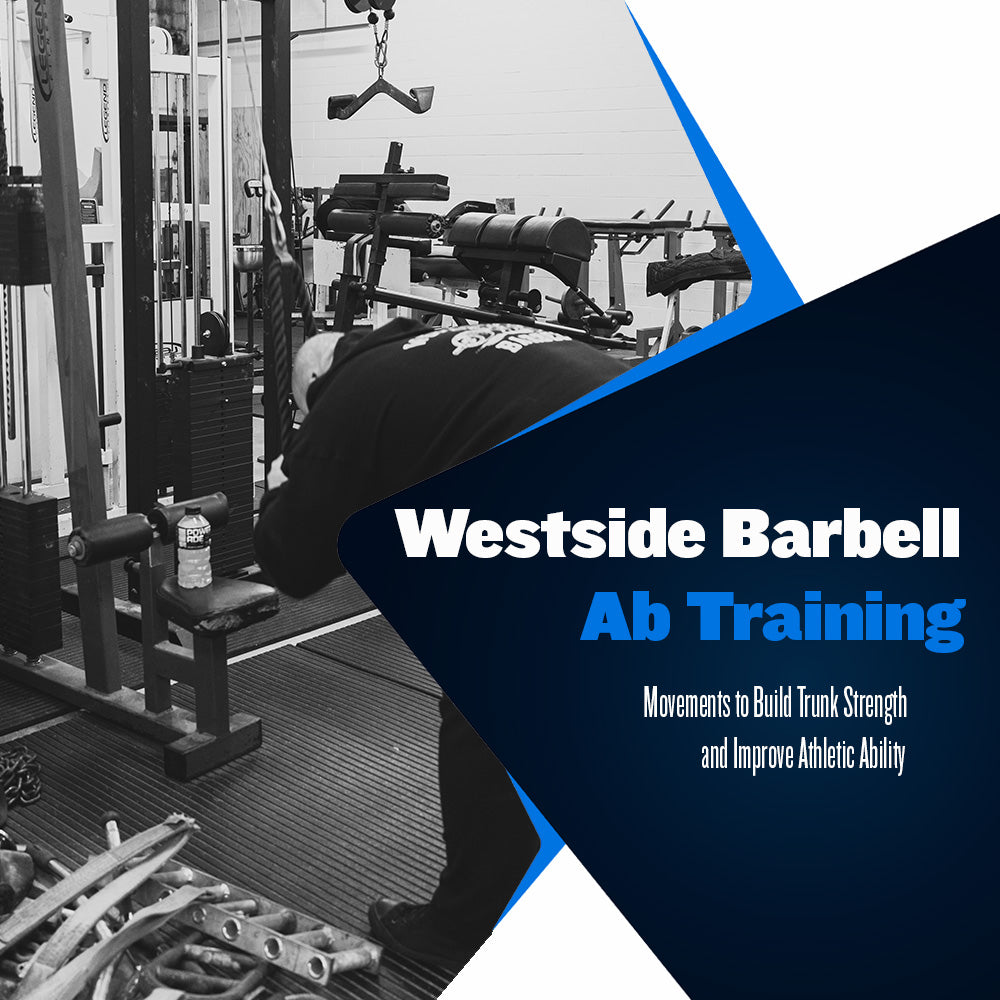Westside Barbell Ab Training

In the gym, our focus is to build strong, fast, and resilient athletes. To do this, we must ensure that all major muscle groups are trained regularly. The abdominal muscles are a group of muscles that play a vital role in strength and athletics. These muscles allow an athlete to create ideal levels of intra-abdominal pressure and work with the extensor muscles of the spine to provide optimal spinal stability.
It’s simple; if you want to become as strong as possible, you must have a strong trunk. Without the ability to create a strong brace, you will miss lifts or experience a lower back injury that forces you to take time off. If you have a weak trunk, it is only a matter of time before something goes wrong.
At Westside, we are constantly improving the strength of our abdominal muscles. Whether through direct or indirect work, our abdominal muscles play an essential role in many of the lifts we perform. Not only do our ab exercises improve our ab strength, and movements like squats, deadlifts, and even overhead presses help improve our abdominal strength and stability.
Here are a few of the most common abdominal-focused exercises we use at Westside Barbell:
Standing Abs
This exercise would probably be considered the standard abdominal exercise performed at Westside Barbell. Standing abs are relatively easy to perform, provided you know how to target the abdominals appropriately.
To begin this exercise, you will want to hook up a cable rope attachment, or something similar, to a cable pulldown machine. You will then grab the rope attachment with both hands and create tension in the cable by pulling your elbows towards your pecs. You should feel your abs working against the rope tension if you stand and hold this position.
Once you have achieved that feeling, you will essentially perform a crunch from the standing position by pulling the rope down towards your waistline. The trick to maximal abdominal involvement is avoiding pulling the rope with your arms. You want to flex your abs and focus on pulling the weight down with your elbows.
What we mean by “pull the weight down with your elbows” is to avoid using the arms to pull the rope; instead, use the upper torso (elbows) to start the movement while using the abdominal muscles to accomplish the entire movement. If properly executed, each rep should focus on the abdominal muscles just as a crunch would.
If you are having issues executing this movement due to excessive arm involvement, grab the rope tight and bring it into your chest. From there, begin flexing your abs and notice how the chest folds into the torso, causing tension to increase. This should allow you to experience proper abdominal engagement.
Banded GHR Sit-Ups
Another staple abdominal exercise frequently performed at Westside Barbell is GHR sit-ups with a band. This exercise was one of Lou’s preferred ways of targeting the abdominal muscles. To set this exercise up, you will take a band that provides the required tension and attach it to the base of the GHR. If attachment points are limited, you can use a dumbbell as an anchor.
Once the band is attached, you will get on the GHR in position to allow yourself to perform a sit-up. At this point, you will then wrap the band around your torso, preferably at upper chest level. You can do this on your own if you have the mobility or have a training partner help you.
From there, this movement is simple to execute. You will perform sit-ups on the GHR against band tension. You want to utilize the full range of motion the GHR allows. This will provide excellent training for the abdominal muscles and hip flexors, improving trunk strength and athletic performance.
Weighted Leg Lifts
Leg lifts are a great way to target the abdominals and hip flexors, similar to the banded GHR sit-ups. At Westside, we have a machine that allows us to load 10-25lb plates to provide resistance during the exercise. If you do not have access to such a machine, you can wear ankle weights or attach a band to an anchor and wrap it around your ankles to provide resistance.
Weighted leg lifts are simple to execute; you will lift your legs while keeping them as rigid as possible until your legs and torso form a 90-degree angle. You should feel a significant strain in the hip flexors and abdominal muscles if performed correctly.
To increase the difficulty of the exercise, you can slow the eccentric phase down each rep, causing the hip flexors and abs to perform even more significant amounts of work.
How to Program
Programming these exercises into your training plan is simple. Our basic template calls for four training days per week; two lower training days and two upper training days. If you need to improve your trunk strength rapidly, you can perform abs every training day. Otherwise, you will complete ab training towards the end of each lower body training day.
No matter the exercise, the sets and reps will typically be the same. If you are a beginner with a weak trunk, we recommend 3-5 sets of 12-15 reps. If you are an experienced lifter with strong abdominals, we recommend 4-6 sets of 20-30 reps.
To become as strong as possible, you must include abdominal exercises. No matter the lift, having the ability to stabilize the spine via a strong brace will always allow your body to display more significant levels of strength. It’s simple; stable spine = strong lifts. Don’t disregard abdominal training.
Sources:
Simmons, L (2015). Special Strength Development for All Sports. Westside Barbell
Simmons, L. (2007). Westside Barbell Book of Methods. Westside Barbell.
Verkhoshansky, Y., & Siff, M. C. (2009). Supertraining. Verkhoshansky.





